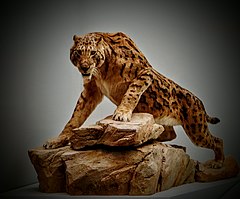Megantereon
| Règne | Animalia |
|---|---|
| Embranchement | Chordata |
| Classe | Mammalia |
| Ordre | Carnivora |
| Sous-ordre | Feliformia |
| Famille | Felidae |
| Sous-famille | † Machairodontinae |
| Tribu | † Smilodontini |
Megantereon est un genre fossile de grands félins appartenant à la sous-famille éteinte des Machairodontinae (« félins à dents de sabre ») et à la tribu des Smilodontini.
Systématique
[modifier | modifier le code]Le genre Megantereon est décrit par Croizet et Jobert[1] en 1828[1]. Il a vécu en Amérique du Nord, en Eurasie et en Afrique de la fin du Miocène jusqu'au milieu du Pléistocène[2]. Il pourrait être l'ancêtre de Smilodon.
Historique
[modifier | modifier le code]L'espèce type est Megantereon cultridens[réf. nécessaire], décrite par Georges Cuvier en 1824 sous le protonyme Ursus cultridens.
Description
[modifier | modifier le code]
Megantereon devait ressembler à un grand jaguar moderne mais en plus massif. Le seul spécimen complet découvert (en France, à Senèze en Haute-Loire, près de Domeyrat) a une hauteur à l'épaule de 72 cm[3]. Les plus grands spécimens de Megantereon connus vivaient en Inde. Ils pesaient entre 90 et 150 kg (en moyenne 120 kg).
Paléobiologie
[modifier | modifier le code]En Europe, Megantereon devait se nourrir de grands artiodactyles, de chevaux et de jeunes éléphants et rhinocéros[4].
Liste des espèces
[modifier | modifier le code]- Megantereon cultridens (Cuvier, 1824) (espèce type)[5]
- Megantereon ekidoit Werdelin & Lewis, 2000
- Megantereon hesperus (Gazin, 1933)
- Megantereon inexpectatus Teilhard de Chardin, 1939
- Megantereon microta Zhu et. al., 2015[6]
- Megantereon nihowanensis Teilhard de Chardin & Piveteau, 1930
- Megantereon vakhshensis Sarapov, 1986
- Megantereon whitei Broom, 1937
Cladogramme Machairodontinae
[modifier | modifier le code]Le cladogramme ci-dessous des Machairodontinae, est établi par Wallace (d) & Hulbert (d) en 2013[7] :
| |||||||||||||||||||||||||||||||||||||||||||||||||||||||||||||||||||||||||
Bibliographie
[modifier | modifier le code]![]() : document utilisé comme source pour la rédaction de cet article.
: document utilisé comme source pour la rédaction de cet article.
- Auguste Bravard, « Monographie de la Montagne de Perrier, près d'Issoire (Puy-de-Dôme) et de deux espèces fossiles du genre Felis, découvertes dans l'une de ses couches d'alluvion : avec une carte et deux planches », Dufour éd., 1828, 145 pages
- (en) Jordi Augustí, Mammoths, Sabertooths and Hominids: 65 Million Years of Mammalian Evolution in Europe, New York, Columbia University Press, 2002, (ISBN 0-231-11640-3)
- (en) Dick Mol, Wilrie van Logchem, Kees van Hooijdonk, Remie Bakker, The Saber-Toothed Cat of the North Sea, Uitgeverij DrukWare, Norg 2008, (ISBN 978-90-78707-04-2)
- (en) Steven C Wallace et Richard C Jr Hulbert, « A new machairodont from the Palmetto Fauna (early Pliocene) of Florida, with comments on the origin of the Smilodontini (Mammalia, Carnivora, Felidae) », PLOS One, PLoS, vol. 8, no 3, , e56173 (ISSN 1932-6203, OCLC 228234657, PMID 23516394, PMCID 3596359, DOI 10.1371/JOURNAL.PONE.0056173, lire en ligne).
 .
.
Publication originale
[modifier | modifier le code]- J.-B. Croizet et A. C. G. Jobert, Recherches sur les ossements fossiles du département du Puy-de-Dôme, Paris, , 224 p.

Liens externes
[modifier | modifier le code]- Ressources relatives au vivant :
Notes et références
[modifier | modifier le code]- croizet et Jobert 1828, p. 1-224.
- (en) de Bonis Louis, Peigne S., Mackaye H. T., Likius A., Vignaud P., Brunet Michel (2010), New sabre-toothed cats in the Late Miocene of Toros Menalla (Chad). Systematic palaeontology (Vertebrate palaeontology), Comptes Rendus Palevol, volume 9, p.221-227
- (en) Alan Turner & Mauricio Anton, « The Big Cats and Their Fossil Relatives: An Illustrated Guide to their Evolution and Natural History », New York, Columbia University Press, 1997, (ISBN 0-231-10229-1)
- (en) Per Christiansen, Jan S. Adolfssen, « Osteology and ecology of Megantereon cultridens SE311 (Mammalia; Felidae; Machairodontinae), a sabrecat from the Late Pliocene – Early Pleistocene of Senèze, France », Zoological Journal of the Linnean Society, 2007, volume 151, p.833–884. avec 29 illustrations
- « Spécimen fossile », sur mnhn.fr (consulté le ).
- (en) Min Zhu, Yaling Yan, Yihong Liu, Zhilu Tang, Dagong Qin and Changzhu Jin (2015), The new Carnivore remains from the Early Pleistocene Yanliang Gigantopithecus fauna, Guangxi, South China, Quaternary International, doi:10.1016/j.quaint.2015.01.009
- Steven C Wallace et Richard C Jr Hulbert 2013.

